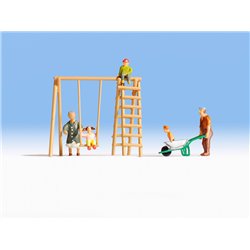One of the most common scatter-related questions asked in model shops around the world is - How much do I need? And...
No products
Product successfully added to your shopping cart
There are 0 items in your cart. There is 1 item in your cart.
Search Tips
Christmas and New Year
We are dispatching orders every weekday apart from Christmas Day, Boxing Day and New Year's Day.
If you select next day delivery at checkout, please note deliveries are not made on public holidays or Sundays.
The shop in Sandown is open 23rd and 24th December, then closed from 25th December, reopening on 30th December.
What is a good age for a child's first layout?
Several factors will influence the age at which your child is ready for their first layout. These include the manufacturer's minimum age recommendations, your child's interest in railways, and most importantly, your ability to view the project from your child's perspective.
Manufacturer's minimum age recommendations: These are to indicate the age at which children can handle their product safely without causing damage to either themselves or the model. How much you take notice of these recommendations is your prerogative, but it should be remembered that little hands can easily drop things regardless of value, so expensive, exclusive or cherished engines are probably a no-no.
Child's interest in railways: If your child is already potty about trains, they'll likely love playing with a layout, but if they have previously not shown much more than a passing interest, save yourself a lot of time and money by trying them with a simpler train set on a track mat first to see if their interest develops. You've not lost anything if it does, all of the track, the controller and the trains can all be reused when you construct a proper layout for them.
See the project through your child's eyes: This is probably the biggest factor that will decide whether your child enjoys playing with a layout. For you, a very large, highly detailed layout that perfectly represents an era or location will provide hours of entertaining running sessions, however, not many children under the age of ten will care much about any of that. Children love to touch things, load wagons (either with realistic wagon loads or Lego bricks, they don't care which) and have lots of buttons to press. With this in mind, the size of a layout is not as important as the play value it offers. The kind of track layouts featured on the aforementioned track mats are ideal for children, they provide lots of action within a condensed space and won't take you years to construct. The latter is important because children will find it boring waiting for a complex layout to take shape.
Features that children particularly find interesting include tunnels, working signal lights, stations, level crossings and car loading ramps so try and include some of these. If you really want to incorporate some advanced modelling, why not include a working windmill or a factory chimney with real smoke? Try to keep fragile scenery to the middle of the layout leaving space around the edge for little hands to reach the models without knocking over telegraph poles and trees, etc. And avoid DCC as children like to see immediate cause and effect.
These tips may not give much scope for a realistic railway in miniature, but the resulting layout will be fun to play with and surely that's the whole point. Model railways of this type can be enjoyed by children of almost any age from as young as six or seven (under adult supervision of course), but be prepared that in a child's eyes, a Mk.4 coach coupled to a flatbed, piled high with Smarties, being hauled at full speed by a tank engine, is simply marvellous!
So the real question that should be asked is not, when will little Jimmy or Jane be ready for their first layout? but more, is their mum or dad ready for the challenge?
Click here to receive the tips weekly in your mailbox. You can unsubscribe at any time.










